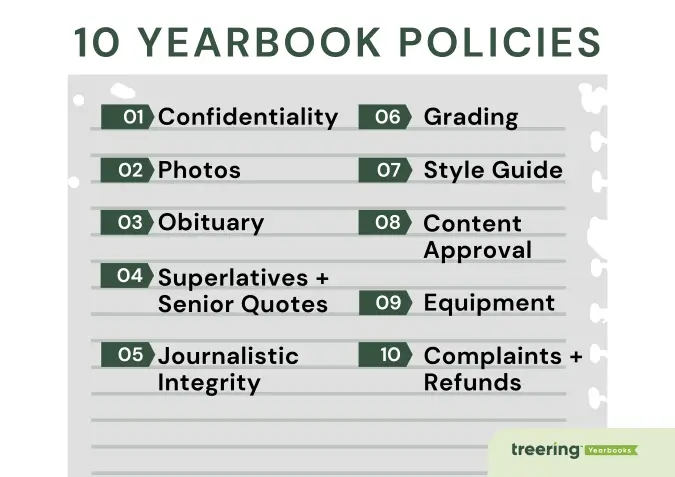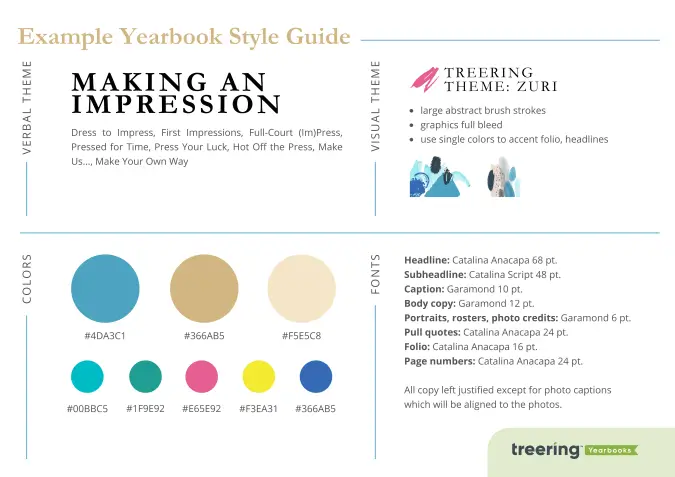
Erikalinpayne
January 14, 2025
2
Min Read Time

If I could return to year one of advising, I’d draft a staff manual. Yearbooking (yes, it’s a verb) would have been much simpler. I’m not talking about contract negotiation so much as how to deal with sports editors who cannot get a ride to a game or reporters who only interview their friends. Or the “finished” spread with “Lorem ispum dolor” still filling the caption boxes. Or how to tell a senior parent you cannot legally publish a screenshot from a mall photographer’s online proof system. Phew.

A tenet is a doctrine you hold to be true. The first section of your staff manual should define your non-negotiables. These could be class culture and coverage goals. They could also include specific ways your yearbook program aligns with your school’s mission. Or, you could take a different approach and schedule workdays to create your book in chunks.
It’s your call. You determine what is valuable to your community. Here's what's in mine.

Coverage is a non-negotiable because our school claims to be a “People-first” learning community. If a student is excluded from the historical record of our campus, the yearbook team undermines the mission. That said, we’ve never had 3x coverage for 100% of the 423-person student body; on average, it’s 94-96%. And because Treering’s three-week turnaround allows us to add the students who transferred in through mid-April, hardly anyone is ever a zero.

Middle and high schools use yearbook policies to govern student roles, responsibilities, procedures, and behavior; adult teams might need to establish guidelines for
If your group is parent-led, there may be turnover. These policies will help the next adviser.
By taking time to craft some policies for your staff manual, you will also codify what your program looks like. For example, if you have a large class (or two) completing the yearbook, you will want to have procedures for group and editorial board communication, chain of command, and the like. A team of five will not.
For a smaller yearbook team, it helps to establish boundaries to prevent burnout. Use your policies to protect one another such as how you will prioritize coverage when you can’t be everywhere.
Parent groups, yearbook classes, and clubs of any size also need job descriptions (see the next section).
Try to keep this under five pages, including the rubrics and/or checklists. Admin needs to sign off on these. Physically. That signature will go a long way when a parent or student challenges you.
Here are ten policies to include in your yearbook staff manual:
Use this section to outline what you keep quiet and what you share pre-distribution.
What guides the bulk of your content?
This is the toughest policy to craft while grieving. I learned the hard way. A group text from the vice principal requested an emergency staff meeting before school. Two students died in an automobile accident. One was racing without a license. The other was walking home.
Momentarily putting aside the denial, anger, and bargaining, we had to decide how to honor two lives. Thus, the following became our policy:
If within press time, Warrior Yearbook will provide a ¼ page space with the following:
No additional information will be included. All student ads will feature a family-submitted photo and will have parent approval. Next of kin will provide the photo and approval for staff memorials.
Here are more examples of obituary policies.
These are two of the most controversial areas between your yearbook covers. Add relevant dates, submission guidelines, crowdsourcing avenues, etc., to your policies.
Part of your yearbook superlative policy should include:

Personal opinion: Instead of senior quotes that focus on one group on your campus, why don’t you improve your journalism by building expanded captions into your designs? This way, you have quotes on every page from every grade. Now that’s people first.
If senior quotes are a golden calf, craft a policy that outlines
Use this section to define how you will legally license and attribute outside content, and the role of AI in your newsroom. (Chances are, your district already has a written policy you can cite.)
This is also a great spot to explain the characteristics of reporting: it’s free of editorializing, defamation, or discriminatory content. What safeguards will you include?
Yearbook is the hardest “easy A” my students ever earned. (Wait for it…) Because of that misconception, include spread checklists and grading rubrics in this section so there is no question come progress report time. This is also a great area to outline your workflow and deadline schedule.
This section provides clear instructions on theme elements to ensure consistency across the yearbook. With these decisions made early on, your team can focus on what truly matters: content.

Many advisers stop there. I would push you to expand your yearbook style policy to include writing.
.webp)
Who approves layouts, photos, and written content, and what is the order of approval? If you have mini-deadlines for reviews and revision, include them here. Treering advisers, allow yourself time to order and review your printed proof.
There may be some overlap with your grading section, and that’s OK.
This section of your yearbook policy manual should clearly outline the rules and expectations for borrowing, using, and returning yearbook equipment. Here's what you might include:
Bottom line: this should complement your district policy on technology usage.
After a disastrous first year where everyone created their own editor title, an experienced adviser sat me down and said, “You need to spell it out.”
That nugget provided the missing piece to my yearbook classroom management.
If you’re a teacher, yearbook is another class. It requires scaffolding and instructional time. It’s also a business: you’re creating a project that requires financial resources. Use the job descriptions below to organize your team, create a chain of command, and align your grading expectations.
If you’re a parent volunteer working with other volunteers, use these job descriptions to provide role clarity for your team. (And if all else fails, we have a blog for that too.)